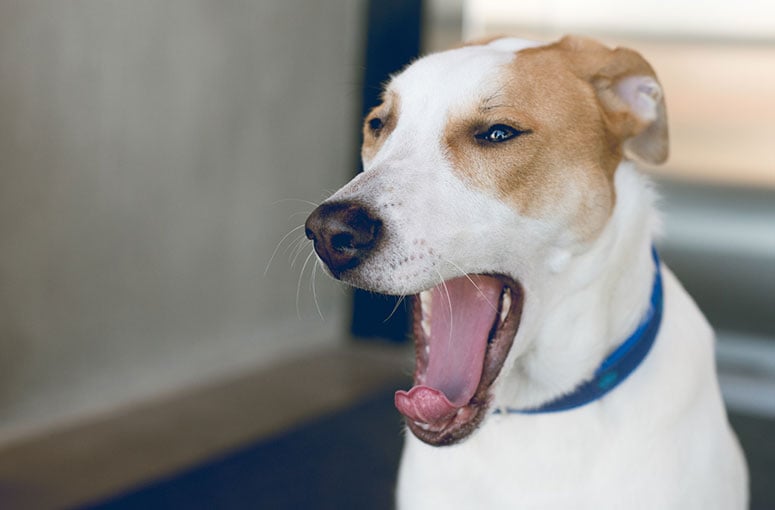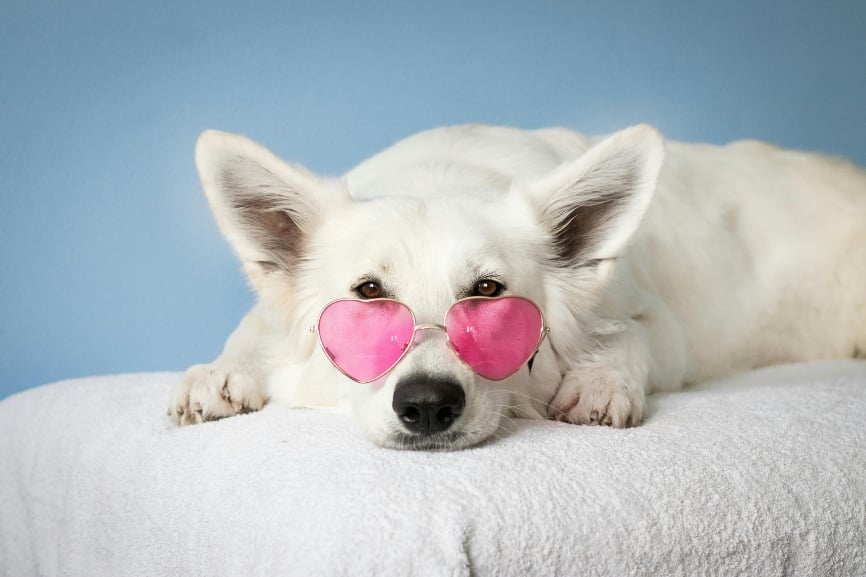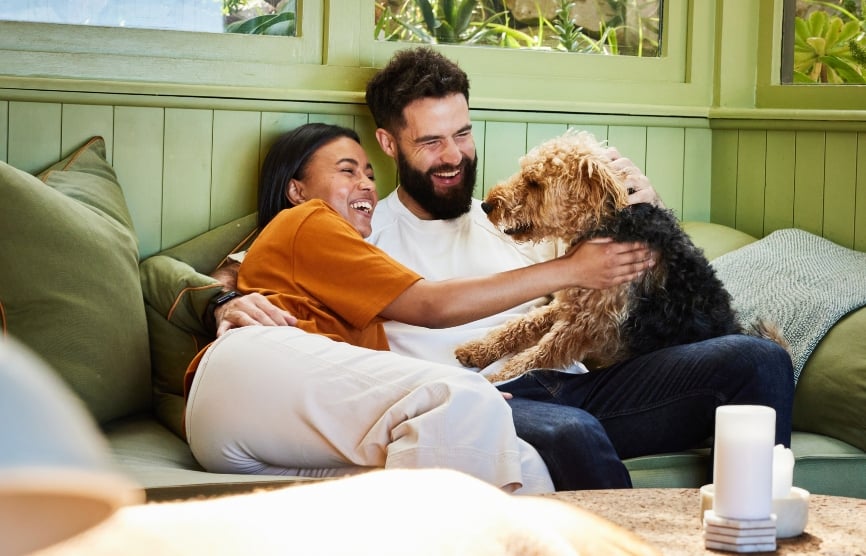Table of Contents
Key Takeaways
- Dogs yawn when they are sleepy and when they are anxious or learning something new.
- Pet parents need to learn how to read their dog’s body language to understand their needs and help them feel safe.
- Besides yawning, dogs also sigh, lick their lips, and stretch or shake when they feel nervous and when they are processing and learning.
For people, yawning is usually a sign of fatigue or sleepiness. Sometimes this is also true of a dog yawning, but yawning can have multiple meanings in our canine friends.
Dogs may yawn when:
- Waking up from sleeping
- Preparing to sleep
- Relaxing
- Feeling overwhelmed or nervous in a situation
- Learning a new behavior in training
We have to look at the context to determine why a dog is yawning. Sleepiness aside, let’s look at the other reasons dogs yawn.
Yawning due to anxiety
The reasons for yawning are not fully understood (in dogs or in humans), but it does appear to be one way dogs react to stress or anxiety. It seems that dogs yawn to calm themselves when they are uneasy.
For example, if you’re out on a walk and stop to talk to a neighbor, you might notice your dog yawn. This is because your dog is either uncomfortable with the person or wants to get moving again. Or your dog may yawn when you are going into the veterinarian’s office or when a child hugs them. Knowing your dog’s triggers will help you identify when their yawning is due to stress.
Another sign of a stressful yawn is that it is more prolonged and intense than a sleepy yawn, and may be repeated several times.
Yawning due to learning, behavioral changes or excitement
Neuroscientist Robert Provine has done extensive research that shows that yawns often come during moments of transition from one behavioral state to another. This is why dogs often yawn when they are learning something — they are processing new information and changing their mind.
For example, during a training session to address a behavioral issue, your dog may yawn to release stress. This is because they begin to relax and understand that it is not their job to take care of you. Or a dog may start yawning a lot during a training session as they are having difficulty continuing to focus, their brain is tired, and they need a break.
Dogs also yawn in anticipation of something enjoyable, such as a walk—this is a way they are controlling their enthusiasm. For example, if you require your dog to be calm before leaving their yawning shows that they are exhibiting self-control by not jumping up and barking excitedly.

How a human yawn can help your dog relax
Yawning is a calming signal for dogs, used to calm themselves and communicate their peaceful intentions to others.
If you notice that your dog is showing signs of anxiety, you can yawn yourself to help them feel more relaxed. However, don’t cover your mouth to be polite when you yawn, as dogs don’t do this, and they won’t see you yawn.
You can apply this, for example, if your dog hears a noise and they appear to be anxious. You can yawn without looking at them or saying anything. This message lets your dog know that there is nothing to worry about. And don’t be surprised if they yawn back. As in humans, yawns are contagious among dogs and between dogs and their people.
Other behaviors that indicate anxiety or learning
Yawning is just one of the ways that dogs exhibit anxiety and show that they are learning something new. Dogs also sigh, lick their lips, stretch, and shake.
Sighing
When a dog sighs, they are not conveying they are bored or depressed, as you may think; rather, they are releasing anxiety and finally able to relax. Think of a mother with twin 2-year-olds who just got both babies to sleep and can finally have a little time to relax.
Dogs may sigh when:
- During or after a training session. It’s a sign that they are absorbing the information.
- You are addressing a behavioral issue. It’s a sign that they are changing their mind about who the pack leader is.
- The stress or responsibility your dog feels to protect is starting to diminish.
- Your dog is relaxing.
Licking their lips
You may notice that your dog sometimes licks their lips, which is another signal that your dog could be feeling anxious or learning a new habit.
Dogs may lick their lips when:
- They are enjoying their food or a treat or anticipating something yummy.
- Feeling stressed or overwhelmed in a situation.
- You are addressing a behavioral issue. This is a signal that they are thinking and absorbing new information.
Stretching
Dogs stretch for more than one reason — and it’s not always because they are waking up from a nap.
Dogs may stretch when:
- Releasing stress
- Learning to cope in a new situation
- You are addressing a behavioral issue. It’s a sign that they are processing and releasing tension.
- Relaxing their body before resting
- Waking up from sleeping
Shaking
If you see your dog shaking, this can mean several different things, depending on the situation.
Dogs may shake when:
- Feeling constantly stressed. This is usually a full-body shaking.
- Finishing a bath or swim usually followed by rolling in delight.
- Releasing anxiety. This is generally like a ‘shoulder shake,’ just as we shake our shoulders to relieve tension.
- You are addressing a behavioral issue. A ‘shoulder shake’ is a sign that they are learning and starting to believe in your leadership.
- Your dog is relaxing.
Every dog is unique
Keep in mind that every dog is unique and will have their own way of showing you that they are either stressed or processing. Some dogs yawn, sigh, lick their lips, stretch, and shake, while others may only exhibit one or two of these behaviors. Very emotional dogs tend to be more expressive in their behavior and often have more ‘tells’ or display them more frequently.
Look at the big picture
If your dog is yawning, sighing, licking their lips, or stretching a lot, it can signify they are either in a heightened state of learning or are very stressed. It is normal for dogs to express their emotions in several combinations, so don’t panic if your dog starts to yawn.
Look at your dog’s posture. Are they laying down, sitting, or standing up? Is their body relaxed, or does it look tense? What is the environment? What is the behavior of the people or other dogs around your dog? How are you feeling? If you feel stressed, overwhelmed, or upset, your dog may reflect your emotions.
When you see your dog yawning or showing other signs of stress, your goal should be to help your dog feel better, by avoiding the situation or showing you are the leader and will protect them. For example, suppose your dog is yawning and licking their lips a lot at the dog park, and they don’t seem happy interacting with the other dogs. In that case, this is your dog’s way of communicating that they would rather not be there.
Other situations where your dog may feel stressed
When a dog is yawning, sighing, licking their lips, stretching, or shaking around another dog in the home, it’s usually a sign they feel intimidated or uneasy with the other dog. In this case, it’s crucial to hire a trainer who specializes in behavioral issues to help you learn how to resolve the stress and create harmony in your home.
Sometimes dogs will show they are uncomfortable with a visitor in your home by expressing their anxiety in undesirable ways. They may growl, nip, bark, or lunge at your guest. As you help them learn that they don’t need to be afraid and start to feel safe around your visitor, they will yawn or show other stress-releasing behaviors as they process this information.
It’s essential to pay attention to what your dog communicates to you. As you start to notice their ‘tells,’ you can more easily learn how to help and understand them.
Sarah-Anne Reed is a holistic dog trainer and owner of Pack Dynamics®. Her practice focuses on understanding and respecting dogs as a different species and honoring them as individual beings.
This article is copyrighted by Sarah-Anne Reed and Pack Dynamics®, and no reproduction of this article without the express permission of Sarah-Anne Reed is permitted.
25% discount for online dog training
Pack Dynamics® offers a unique online training program, ‘Fluent In Canine®‘. Learn how to understand your dog’s behavior and address typical behavioral issues, like separation anxiety, excessive barking, pulling on the leash, puppy issues, and more, as you create a deeper bond with your dog. The training program includes consultation support via text/phone with owner/trainer Sarah-Anne Reed. Visit the Fluent In Canine® page and enter this code at checkout to receive 25% off: HPPI2022









